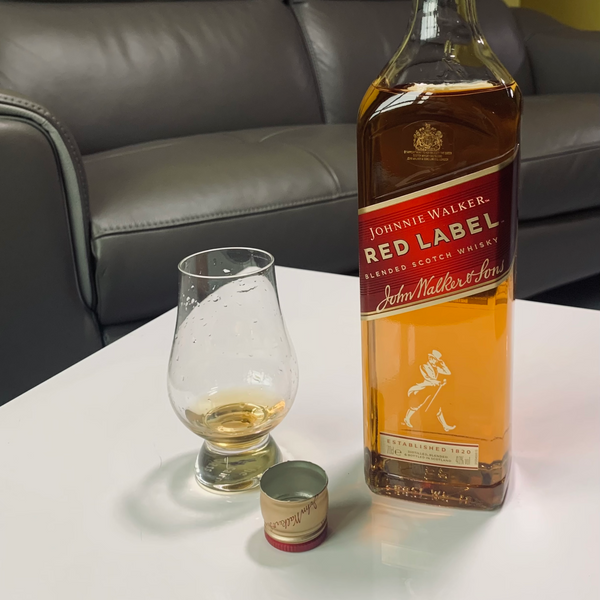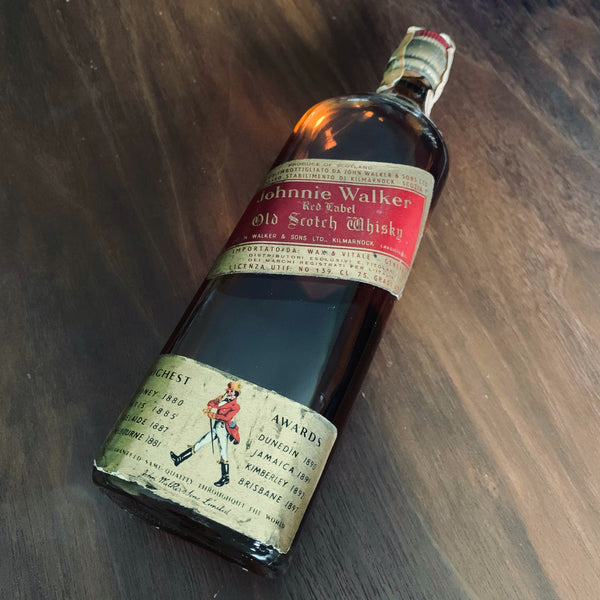
One of the advantages of being a fan of whisky- over say wine or beer- is that you can relatively easily procure whiskies bottled over half a century ago in a rather good condition. A Johnnie Walker left forgotten on the shelf by your granddad in his thirties remains more or less the same condition right until it is uncorked by your own children in 2055. The same can’t always be said of wine or beer, which tend to evolve over time even after bottling.
So, it’s always a fun experiment to run a vertical tasting of whiskies from the same whisky producer from different decades.
With the extraordinary rise in prices with rare single malts in the secondary market, vintage blended whiskies from the 1960s – 1980s have been attracting quite a bit of attention lately for their purported quality and value for money.
We shall begin with a label and bottle many are familiar with: the Johnnie Walker Red Label. We got ahold of a Red Label bottled around 2020, and a vintage Red Label distilled in the 1960s, and we would be conducting side-by-side vertical taste test.

Inarguably, the Johnnie Walker is the world’s best-selling Scotch brand available in almost every country. Founded in 1860 by John Walker, the brand credits its success to John’s son, Alexander Walker, for getting bottles on to numerous ships travelling around the world.

In the 1860’s, Alexander Walker astutely appointed ship captains as Johnnie Walker’s agents so that the brand would be carried all over the globe. And because normal cylindrical whisky bottles are prone to rolling and breakage during transportation on a ship, Alexander conceived of Johnnie Walker’s famous rectangular bottle that conserved space and ensured the whisky arrived intact.

Other distinctive features of the brand included the 20-degree slanted label, and the “Striding Man” motif which helped separate JW from its competition. This “Striding Man” was originally conceived as a flamboyantly dressed Victorian man in a top hat, bright red suit and monocle.


The Red Label is an important part of the standard JW core range of whiskies introduced in 1909. The blend combines grain and malt whiskies from up to 30 distilleries over Scotland, including Linkwood and Clynelish distillery- which produce very good quality single malts.
Despite our fascination with single malts, I suspect many of these Diageo portfolio distilleries would have been mothballed in the whisky crash of the 1980s, if not for their importance to Johnnie Walker blend. So a blended whisky such as Johnnie Walker was arguably the saviour of a large number of distilleries in the Scotch world.
The general taste profile of Johnnie Walker Red Labels is supposed to include spiciness, vibrant smoky flavours, mellow vanilla, zestiness and a long lingering smoky finish. But how would today’s Red Label compare to one distilled over 50 years ago?
Let’s find out!
Johnnie Walker Red Label, circa 2021, 40% abv (the modern bottle)
Malty and Dry
Note: We assign every bottle we review to one of five Flavour Camps, based on the most dominant flavours found. The Flavour Camps are : (1) Fragrant and Floral, (2) Fruity and Spicy, (3) Malty and Dry, (4) Rich and Round and (5) Smokey and Peaty. To learn more about each Flavour Camp, please click here.
The Bottle

Bottle Stats
|
Distillery: - |
Brand: Johnnie Walker |
|
Region: Scotland |
Status: Active |
|
Distributor: Original Bottling (OB) |
Classification: Scotch |
|
Style: Blended Scotch Malt and Grain Whisky |
Cask: - |
|
Age: NAS (est. 5 to 8 years) |
Abv: 40% |
Tasting Notes

In the glass, the whisky is a dark honey colour with thin legs.
On the nose, the aroma is on the whole, very smooth, friendly and honeyed. The aroma opens with primarily caramel, toffee and honeyed notes that really take centre stage.

As the aroma opens up, I start getting a light solventy note reminiscent of fresh unpeeled bananas and nail varnish that lingers for several moments. This flavour profile is really quite distinctive of many grain whiskies.

This develops to a orange peels, a subtle fragrance of dried lavender and notes of smoky Oolong tea.

Unsurprisingly, this is gentle and friendly on the nose with no prickliness whatsoever.
On the palate, the whisky is light bodied, lightly fragrant and relatively straightforward in character. The palate is malt-heavy with an abundance of yeasty, bready, biscuity notes that take over the palate. Reminiscent of digestive biscuits and a freshly baked sweet rolls. Maltiness very gradually develops into some vanilla and oak character.

There is not much sweetness to be seen, but a mild raisin character amid the yeasty bready notes that gives a sensation of eating very light raisin bread.

As the maltiness begins to recede, the grainy solvent notes are revealed once again. Light notes notes of nail varnish and fresh bananas.
There is also a well-integrated note of very mild smokiness and a barely noticeable note of Sarsaparilla underlying the primary flavours of the whisky.

The finish is relatively short, with a fading saccharine note of honey, receding tobacco smoke and some drying leatheriness.
Johnnie Walker Red Label, circa 1960, bottled for the Italian market, 43% abv (the vintage bottle)
Rich and Round
Note: We assign every bottle we review to one of five Flavour Camps, based on the most dominant flavours found. The Flavour Camps are : (1) Fragrant and Floral, (2) Fruity and Spicy, (3) Malty and Dry, (4) Rich and Round and (5) Smokey and Peaty. To learn more about each Flavour Camp, please click here.
The Bottle

Now, when it comes to the vintage Johnnie Walker, the bottle is certainly an artefact worth taking a closer look at.
Elements of design are very similar to the modern bottle. Rectangular bottle and 20-degree tilted label. There is also a colourised Striding Man motif at the bottom with a list of awards won by the expression around the world at whisky tasting competitions.

The main difference is really the cap of the bottle. While the modern one is an aluminium screw-cap, the 1960’s Johnnie Walker had a cork stopper with an Italian liquor tax label over it (this bottle was originally imported for the Italian market by Italian luxury goods conglomerate Wax & Vitale).

The 50-year-old cork stopper really gave me quite a bit of agony as it broke from the cap and threatened to disintegrate when I tried to pop it open. I prevailed nonetheless after a tortured hour of prodding at the cork out in one piece. Anyway, here's the old cap design:

Bottle Stats
|
Distillery: - |
Brand: Johnnie Walker |
|
Region: Scotland |
Status: We expect certain distilleries to have been mothballed by now. |
|
Distributor: Original Bottling (OB) |
Classification: Scotch |
|
Style: Blended Scotch Malt and Grain Whisky |
Cask: - |
|
Age: NAS (est. 5 to 8 years) |
Abv: 43% |
Tasting Notes

In the glass, the colour of the whisky is indistinguishable from the modern Red Label. Yet swirling it reveals slightly thicker legs that suggest this would have a thicker mouthfeel.
On the nose, you immediately realise that the two bottles are as different as day and night. This one contains a little more spice than the modern Red Label, but has greater depth of flavour, heaps of red fruits and berries, and a more distinctive earthy character.
Initial nosing brings an abundance of fresh cranberries and raspberries that fill your nose. There’s also a nice brightness and freshness to this aroma despite being locked away in a bottle for 50 years.

These notes are accompanied by a similar malty-bready note found in the modern Red Label. Yet unlike the modern bottle, here, there’s an additional dimension of sweet creaminess that really elevates the aroma profile and gives it substantial complexity.
These notes of fresh red fruits, creaminess and maltiness cohere together in a way that might remind you of a strawberry parfait with granola.

There is some similarities with the modern Red Label. As the aroma continues to open up, there are also some orange peels, notes of lavender and mild smokiness. Yet once again, the freshness of these notes is surprising and intriguing. It’s almost like this was just bottled a year ago.

On the palate, this whisky is rich, medium-heavy bodied, very well-rounded and really quite complex.
The first sip brings out lashings of strawberry jam on toast. Substantial fresh sherry notes carrying with it a moderate but satisfying level of sweetness (recall that the modern Red Label is rather contrived and saccharine). This is paired with a mild cereal note and dryness.

This sweetness is followed very closely by some rather earthy and nutty notes that coat the tongue and linger. A scattering of lightly sweet and slightly savory honey-and-sesame walnuts.

Chinese walnuts lightly coated with caramel and sesame seeds and are the best part of a classic Hong Kong snack. These nuts are a chore to make — the nuts are boiled, deep-fried, then tossed in roiling caramel. (Image Source: The LA Times)
As the flavours further develop, the nutty notes turn slightly smoky, while heat and spice begin to rise towards having the spicy-sweet flavour of candied ginger.

The finish is long and refreshing but with a mentholated quality- kinda like having a diluted Moroccan mint tea, which is accompanied by a gradually fading note of aromatic incense smoke.

My take
This was a fascinating comparison! There are discernable similarities between these two whiskies. Both are relatively gentle on the palate. Both have a similar maltiness and leatheriness on the palate and varying degrees of a tea-like character.
Yet the differences are immediately noticeable on first nosing. It’s like night and day really. The 60’s Red Label has a lot more depth, texture, character and complexity. There is more fruitiness and creaminess in it, and feels like a three-piece orchestra composed of a cello, viola and violin.
The modern Red Label on the other hand is less complex and its notes are front and centre. Yet it feels slightly smoother and easier to drink- perhaps due to its lower alcohol content. Going back to the orchestra analogy, the modern Red Label plays more like a violin solo.
It’ll also be quite obvious to single malt drinkers that the modern Red Label relies much more heavily on grain whisky rather than malt whisky. This is clear from the obvious amount of solventy notes in its flavour profile.
I really like the vintage Red Label. There’s a surprising amount of depth, complexity and well-rounded notes that can rival good single malts. Yet I suspect that the newer recipe might be made to appeal to modern drinkers from the international markets. There is considerable smoothness and very little heat or smokiness in it.
|
Our Rating for the modern Red Label |
🌎 Smooth, easy to drink and rather straightforward flavour profile. After all, this is intended to appeal to people from around the world who are newer to Scotch.
|
|
Our Rating for the vintage Red Label |
🎻🎷🪗 Much more satisfying depth, surprisingly well-balanced and quite complex. This would really impress Johnnie Walker cynics of today and make them shed a tear for yesteryear. |

@charsiucharlie







